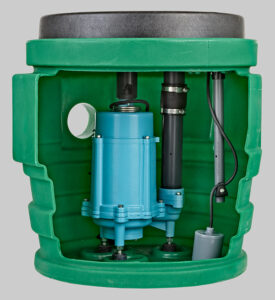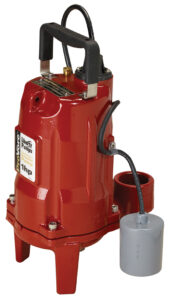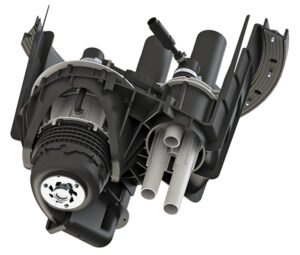
Pump and Grind
March 6, 2024 | By Doug Picklyk
Plumbing pros have options when working against gravity with below grade sewage lines, and more and more it’s grinder pumps to the rescue.
We’ve all heard the expression, “What goes up must come down,” but what goes down doesn’t always go up. At least that’s the lesson many plumbing pros have learned when dealing with below grade sewage ejection.
Plumbing works best when gravity plays a role. Ancient Greeks and Romans, inventors of the earliest toilets and sewage systems, understood the principle of moving wastewater downhill. But inevitably today plumbers are faced with sewage systems in new developments, home renovations or simply challenging situations where the main municipal or septic system drain leaves no option but to pump it up.
For residential basement washroom installations in homes where no gravity sewer lines exist, manufactures have designed macerating up-flush toilet systems for easy installation without needing to break open concrete floors. These systems include a toilet that flushes into a pump tank which macerates sewage waste and pumps it up and away through discharge pipes. A tidy solution for simple residential applications.

A cutaway example of the Pit+Plus Jr. sewage pump package system from Little Giant.
However, for renos with additional plumbing demand—adding a complete basement suite, kitchen and laundry for example—a more robust solution is required and that involves the installation of a sewage ejection pit. This process involves breaking concrete to install drainage piping that will feed into a prefabricated packaged pit system.
Within these packaged systems, will be a sewage, or solids, pump that will trigger to turn on with a float system once reaching a set volume. The pump will lift the wastewater away often through a 2-in. discharge pipe. The package systems include an access cover with outlets for venting and discharge, along with alarm system options to warn of any malfunction. These systems offer a standard ½-horsepower (hp) solids handling sewage pump which is suitable for many simple residential applications. But not all applications are simple.
The Grinder
The greatest challenge for standard sewage pumps come from unintended objects ending up in the sewage pit.
“People tend to treat the toilet like a garbage can these days, and it’s getting worse and worse,” says Steve Ritsema, Liberty Pumps national sales manager for Canada. He notes that for most homeowners a regular sewage or solids pump is going to run fine, but if it’s a basement rental suite, he recommends putting a grinder pump in the pit from the start.
“Airbnb is a huge issue,” says Ritsema. “There are a lot of basement suites and many of those renos have to put in a pump to get sewage up to the city sewer. That’s where we recommend the grinders.”

The ProVore 1-hp residential grinder pump from Liberty Pumps uses the company’s V-Slice cutter technology and can be used as a replacement pump in 2-in. discharge systems.
A grinder pump, like it sounds, has rotating cutting blades designed to macerate and grind solid waste into smaller particles before pumping it through the plumbing system. These powerful pumps, starting at 1-hp, will grind waste into a slurry and provide enough pressure to keep it moving to the main drains.
“We’ve always made grinder pumps for residential as well as municipal applications, and where you’re going to want a grinder is where you’re not going to be in control of what’s going to be flushed down the toilet,” says Jeremiah Brodie, director of training with Little Giant for plumbing and HVAC in Canada and the U.S.
“We all think we have control,” says Brodie, “Until you have children or elderly parents living with you and you may find things going down the drain that are not great for a sewage ejector.”
Both Ritsema and Brodie cite the emergence of “flushable” wipes as a problem for basic solids pumps, as well as a long list of items they’ve seen or heard of plumbers discovering in failed ejector systems. They both agree that flushable wipes and other common usually unflushable disposables are no challenge for a grinder.
There are multiple grinder pump options on the market from manufacturers including: DAB, Liberty Pumps, Little Giant (Franklin Electric), Goulds (Xylem), Pentair Myers, Saniflo, Zoeller and more. The grinders are available in higher levels of horsepower to accommodate sewage lifting from small residential to larger commercial and municipal pumping applications.
“The one horsepower grinders are enough for residential or light duty commercial, but once it’s a true commercial facility like a quick service restaurant, a hospital or a school, it’s recommended to start off at the two horsepower grinders,” suggests Ritsema. Liberty and some other manufacturers make grinders up to 15 horsepower for applications like high-rise apartment buildings and municipal services.
Service Calls
“We demonstrate our grinder pump at trade shows and plumbers will say, ‘I wish I had put this in because I’m sick and tired of servicing sewage pumps,’” says Ritsema.
Replacing domestic ½-hp sewage ejector pumps with a 1-hp grinder pump is an area where Little Giant sees a lot of sales, notes Brodie. And he’s heard from many contractors in the field that going out to fix a sewage ejector is their least favourite job, noting they will charge a minimum of $1,000 for those service calls. “For roughly that cost you can purchase a grinder pump and not have to worry about it,” he says.
And while Ritsema admits grinders may not be entirely perfect for everything that may get flushed—they are only machines after all—they will reduce call backs in 90% if not 100% of the cases.
For some plumbers that effectiveness could be seen as a blessing and a curse. Ritsema recalls one trade show where a plumber approached him after a grinder pump demo and was clearly upset. “That’s a good pump,” he said, shaking his head, “But, you know, I installed 60 of them around a lake and I put myself out of a job.” He wasn’t getting any of his regular service calls.
Thinking about the pump replacement market, pump makers are working to make the pumps more plumber friendly. Little Giant has outfitted its 1-hp grinder with a 1-1/4-in. discharge as well as a 2-in. flange, “so it can easily be retrofitted and not have to be re-plumbed,” says Brodie, noting that typical grinder applications have 1-1/4-in plumbing, where a sewage ejector is going to have a 2-in. or 3-in. discharge.

The Sanipit 24GR retrofit pump kit from SFA Saniflo adapts to most 24-in. diameter pit systems and includes 1-hp grinder and air pressure switch system with triple redundancy.
These pumps also can weigh around 80 lbs., so they are made with attachments for lowering the pumps into a pit. These immersible grinder pumps can also be serviceable. Some coming with replaceable electrical cords and other replaceable parts including cutter blades, impellers and the adjustable rubber feet on the bottom of the pump.
New to the market is a retrofit pump kit from SFA SaniFlo that offers a built-in 1-hp grinder motor and cover that is designed to fit most existing 24-inch pits.
“As sewage pumps have been a largely unchanged and problematic part of the plumbing industry for over 50 years, this solution is poised to disrupt the North American market by offering a hassle-free and high-performance option for replacing faulty sewage pumps,” says Regis Saragosti, CEO of SFA Saniflo North America.
Beneath its cover, this retrofit solution creates a dry working area within the pit keeping the components and the motor separate providing a cleaner experience for service technicians. It includes a 2-in. discharge rubber adapter with a built-in check valve. Instead of a float mechanism it uses an air pressure switch system with triple redundancy.
More Applications
For more intense situations where additional power or failsafe solutions are required, sewage pits with two grinder pumps are available. “Once we go into a commercial application, it’s almost always by code, the design engineer will require duplex with an alarm and a backup pump built in,” says Ritsema.
Other common uses for grinder pumps include pressure sewer systems, this includes entire communities where the sewage needs to be pumped to higher ground. All homes and buildings will be equipped with grinders to move the wastewater with ample pressure.
And more commercial applications, where solids pumps were specified now use grinders to avoid potential downtime due to unflushables.
Yes, gravity is free, never breaks down and works even when the power fails, but when it’s needed, sewage pumps are available to get wastewater where it needs to go. <>




